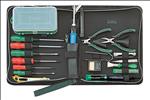 Create your own Multi-OS experience Create your own Multi-OS experience
|  | Author: Steve Jones Date: 04/06/2008 16:25:30 |
How to build your own 3-Pack experience
We do not expect you all to buy the 3-Pack because you may already have most of the equipment you need. We can supply the components you need to construct your own Multi-OS system or point you in the right directions. We will also supply the instructions of how we set up the machines so you can do the same, albeit with multiple computer cases.
Components you need are as follows:
- 4 way KVM switch unit (Keyboard, Video, Mouse) if it has audio then even better.
- Text Clipboard sharing software.
- Gigabit network switch unit 5 way, a 10/100 unit will be ok but you need the high speed transfer between machines to get the best out of it.
- Gigabit network cards for computers that do not have it onboard.
- A high speed large capacity drive for sharing between units.
- A large hard drive for the Time Machine.
We will assume that SYS-ONE is a fast Windows machine and SYS-TWO is a Linux unit. Obviously SYS-MAC is a new Intel based Mac, although this will work with older PowerPC versions.
Connect the Gigabit network together linking the three high speed (if you have them) Ethernet ports to the network switch. The 5th Ethernet port can link to you other network or router box.
Connect the KVM switch, ensuring that the active port, i.e. the default boot is connected to you main machine that you use the most. We use the KVM switch with the VGA port, a single USB connector and Audio out cable per computer. The only problem with these is that the Audio is not mixed together and when you switch you only hear audio from one computer.
Connect the monitor, audio, keyboard and mouse to the KVM switch.
Time to boot up
Turn units on and boot as normal, you may not that the KVM switch does not tell the graphics card on all machines what the monitor is and its features. This may then make the computer drop into default modes. I have found my Windows XP does not do this but the Ubuntu does it each time and so does the Mac sometimes. The cure is to switch the KVM to the machine you are booting so it can recognise during initialisation. It does not matter if you miss it on the Mac; just use the Detect Display option in the display setup option. In Ubuntu I have found a reboot is usually needed.
Now you should be able to switch between the machines easily and see devices in the network navigation in all machines. However, what we do is connect the high speed drive to the Mac because that is likely to do the video recording work which requires high speed access. Then share this drive so that the other machine can read and write to it over the high speed network. Also the other reason is that it can then be backed up by Time Machine which as we have already mentioned is very powerful and user friendly.
So you now have a large drive to use as you My Documents folder on the Windows box and map as a network drive on the Ubuntu box, note you can change the path for My Documents to point to this path, however, this is only going to work if you always run all three machines. I usually leave my WinXP and MacOSX box running and the third gets shut down to cut down on power usage, when away I just leave the WinXP box on. It all depends on how you use your computers. Whilst I am not 100% sure about this, I believe that using the Mac as the document storage, you may get more protection against computer viruses and other threats when stored this way due to the way OSX works with files.
Now you have the basic setup for a workable Multi-OS system, as time goes on I will put more tips up here for making life that bit easier, for example what file formats to use taking into account the problems running cross platform. To give an example, the great iMovie program on the Mac will not allow Windows video formats and not even a lot of its own quick time formats which seems annoying, however, the tool itself is great.
Have fun and more later.
|